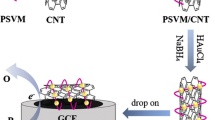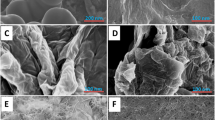Abstract
Polymer-stabilized gold nanoparticles have been reported using an in situ chemical synthesis route where the gold nanoparticles were uniformly dispersed throughout the macromolecular chain and formed a uniform metal–polymer composite material. The surface properties of the composite material were characterized using X-ray diffraction and X-ray photoelectron spectroscopy techniques. The electron transfer resistance (ETR) value of the resultant material was measured using electrochemical impedance spectroscopy technique. By incorporating the gold nanoparticles in the polymer matrix, the ETR value of the composite material was decreased as compared with the pure polymer and showed the efficient catalytic performance for the electrochemical recognition of dopamine. The gold–polymer composite performed as a highly efficient material for the reduction of Rhodamine-B, which suggests that the reduction process was driven by the hydrogen atom transfer mechanism and catalyzed by the gold nanoparticles.










Similar content being viewed by others
References
Gangopadhyay R, De A (2000) Conducting polymer nanocomposites: a brief overview. Chem Mater 12:608–622
Mallick K, Witcomb M, Scurrell M (2007) Directional assembly of polyaniline functionalized gold nanoparticles. J Phys 19:196225
Mahato S, Islam R, Acharya C, Witcomb M, Mallick K (2014) Polymer-stabilized palladium nanoparticles for the chemoselective transfer hydrogenation of α, β-unsaturated carbonyls: single-step bottom-up approach. ChemCatChem 6:1419–1426
Jayalekshmi AC, Sharma CP (2015) Gold nanoparticle incorporated polymer/bioactive glass composite for controlled drug delivery application. Colloid Surf B 126:280–287
Chang H, Liu C, Chen W (2013) Flash memory based on solution processed hafnium dioxide charge trapping layer. ACS Appl Mater Interface 5:13180–13187
Lian W, Liu S, Yu J, Xing X, Li J, Cui M, Huang J (2012) Electrochemical sensor based on gold nanoparticles fabricated molecularly imprinted polymer film at chitosan–platinum nanoparticles/graphene–gold nanoparticles double nanocomposites modified electrode for detection of erythromycin. Biosens Bioelectron 38:163–169
Wei D, Baral J, Österbacka R, Ivaska A (2008) Electrochemical fabrication of a nonvolatile memory device based on polyaniline and gold particles. J Mater Chem 18:1853–1857
Nicolas-Debarnot D, Poncin-Epaillard F (2003) Polyaniline as a new sensitive layer for gas sensors. Anal Chim Acta 475(2003):1–15
Nabid M, Rezaei S (2009) Polyaniline-supported acid as an efficient and reusable catalyst for a one-pot synthesis of β-acetamido ketones via a four-component condensation reaction. Appl Catal A 366:108–113
Tsai T, Pillay V, Choonara Y, du Toit L, Modi G, Naidoo D, Kumar P (2011) A polyvinyl alcohol-polyaniline based electro-conductive hydrogel for controlled stimuli-actuable release of indomethacin. Polymers 3:150–172
Ryu K, Lee Y, Han K, Park Y, Kang M, Park N, Chang S (2004) Electrochemical supercapacitor based on polyaniline doped with lithium salt and active carbon electrodes. Solid State Ion 175:765–768
Kulkarni SB, Patil UM, Shackery I, Sohn J, Lee S, Park B, Jun S (2014) High-performance supercapacitor electrode based on a polyaniline nanofibers/3D graphene framework as an efficient charge transporter. J Mater Chem A 2:4989–4998
Zhang XY, Goux WJ, Manohar SK (2004) Synthesis of polyaniline nanofibers by “nanofiber seeding”. J Am Chem Soc 126:4502–4503
Geniés EM, Tsintavis C, Syed AA (1985) Electrochemical study of polyaniline in aqueous and organic medium. Redox and kinetic properties. Mol Cryst Liq Cryst 121:181–186
Sarma TK, Chowdhury D, Paul A, Chattopadhyay A (2002) Synthesis of Au nanoparticle–conductive polyaniline composite using H2O2 as oxidising as well as reducing agent. Chem Commun 10:1048–1049
Park JE, Park SG, Korkitu A, Hatozaki O, Oyama N (2003) Electrochemical behavior of the polyaniline–organosulfur composite film containing Ag nanoparticles. J Electrochem Soc A 150:959
Mallick K, Witcomb M, Scurrell M (2006) Fabrication of a nanostructured gold–polymer composite material. Eur Phy J E 20:347–353
Xia HS, Wang Q (2003) Preparation of conductive polyaniline/nanosilica particle composites through ultrasonic irradiation. J Appl Polym Sci 87:1811–1817
Xia HS, Wang Q (2002) Ultrasonic irradiation: a novel approach to prepare conductive polyaniline/nanocrystalline titanium oxide composites. Chem Mater 14:2158–2165
Li ZF, Swihart MT, Ruckenstein E (2004) Luminescent silicon nanoparticles capped by conductive polyaniline through the self-assembly method. Langmuir 20:1963–1971
Athawale AA, Bhagwat SV (2003) Synthesis and characterization of novel copper/polyaniline nanocomposite and application as a catalyst in the Wacker oxidation reaction. J Appl Polym Sci 89:2412–2417
Mallick K, Witcomb MJ, Scurrell MS (2006) Polyaniline stabilized highly dispersed gold nanoparticle: an in situ chemical synthesis route. J Mater Sci 41:6189–6192
Granot E, Katz E, Basnar B, Willner I (2005) Enhanced bioelectrocatalysis using Au-nanoparticle/polyaniline hybrid systems in thin films and microstructured rods assembled on electrodes. Chem Mater 17:4600–4609
Tian S, Liu J, Zhu T, Knoll W (2003) Polyaniline doped with modified gold nanoparticles and its electrochemical properties in neutral aqueous solution. Chem Commun 21:2738–2739
Tian S, Liu J, Zhu T, Knoll W (2004) Polyaniline-gold nanoparticle multilayer films: assembly, properties, and biological applications. Chem Mater 16:4103–4108
Tseng RJ, Huang J, Ouyang J, Kaner RB, Yang Y (2005) Polyaniline nanofiber–gold nanoparticle nonvolatile memory. Nano Lett 5:1077–1080
Mallick K, Witcomb M, Scurrell M (2006) Formation of palladium nanoparticles in poly (o-methoxyaniline) macromolecule fibers: an in situ chemical synthesis method. Eur Phys J E 19:149–154
Islam R, Witcomb M, Scurrell M, van der Lingen E, Van Otterlo W, Mallick K (2011) Conjugated polymer stabilized palladium nanoparticles as a versatile catalyst for Suzuki cross-coupling reactions for both aryl and heteroaryl bromide systems. Catal Sci Technol 1:308–315
Scalzullo S, Mondal K, Witcomb M, Deshmukh A, Scurrell M, Mallick K (2008) Polymer-encapsulated metal nanoparticles: optical, structural, micro-analytical and hydrogenation studies of a composite material. Nanotechnology 19:075708
Mallick K, Witcomb M, Dinsmore A, Scurrell M (2005) Polymerization of aniline by auric acid: formation of gold decorated polyaniline nanoballs. Macromol Rapid Commun 26:232–235
Miyama T, Yonezawa Y (2004) Aggregation of photolytic gold nanoparticles at the surface of chitosan films. Langmuir 20:5918–5923
El-Azhary AA, Hilal RH (1997) Vibrational analysis of the spectra of furan and thiophene. Spectrochim Acta 53:1365–1373
Scott DWJ (1969) A valence force field for thiophene and its deuterium and methyl derivatives. J Mol Spectrosc 31:451–463
Feng X, Mao C, Yang G, Hou W, Zhu J (2006) Polyaniline/Au composite hollow spheres: synthesis, characterization, and application to the detection of dopamine. Langmuir 22:4384–4389
Ali S, Ma Y, Parajuli R, Balogun Y, Lai W, He H (2007) A nonoxidative sensor based on a self-doped polyaniline/carbon nanotube composite for sensitive and selective detection of the neurotransmitter dopamine. Anal Chem 7:2583–2587
Yan W, Feng X, Chen X, Li X, Zhu J (2008) A selective dopamine biosensor based on AgCl@polyaniline core–shell nanocomposites. Bioelectrochemistry 72:21–27
Qiana T, Yua C, Zhoua X, Wua S, Shen J (2014) Au nanoparticles decorated polypyrrole/reduced graphene oxide hybrid sheets for ultrasensitive dopamine detection. Sens Actuator B 193:759–763
Wilkinson G, Gillard RD, McCleverty JA (1989) In: Wilkinson G, Gillard RD, McCleverty JA (eds) Comprehensive coordination chemistry: the synthesis, reactions, properties & applications of coordination compounds. Pergamon press, Oxford. ISBN 0-08-035948-5
Mayer JM (2011) Understanding hydrogen atom transfer: from bond strengths to Marcus theory. Acc Chem Res 44:36–46
Mayer J (2004) proton-coupled electron transfer: a reaction chemist’s view. Annu Rev Phys Chem 55:363–390
Bourrez M, Steinmetz R, Ott S, Gloaguen F, Hammarström L (2015) Concerted proton-coupled electron transfer from a metal-hydride complex. Nat Chem 7:140–145
Weinberg DR, Gagliardi CJ, Hull JF, Murphy CF, Kent CA, Westlake BC, Paul A, Ess DH, McCafferty DG, Meyer TJ (2012) Proton-coupled electron transfer. Chem Rev 112:4016–4093
Cao S, Fang J, Shahjamali M, Wang Z, Yin Z, Yang Y, Boey FYC, Barber J, Loo S, Xue C (2012) In situ growth of Au nanoparticles on Fe2O3 nanocrystals for catalytic applications. CrystEngComm 14:7229–7235
Singh C, Goyal A, Singhal S (2014) Nickel-doped cobalt ferrite nanoparticles: efficient catalysts for the reduction of nitroaromatic compounds and photo-oxidative degradation of toxic dyes. Nanoscale 6:7959–7970
Li J, Li W, Qiang W, Wang X, Li H, Xu D (2014) A non-aggregation colorimetric assay for thrombin based on catalytic properties of silver nanoparticles. Anal Chim Acta 807:120–125
Ramakrishna M, Rajesh Babu D, Gengan RM, Chandra S, Nageswara Rao G (2016) Green synthesis of gold nanoparticles using marine algae and evaluation of their catalytic activity. J Nanostruct Chem 6:1–13
Collins A, Zhang X, Scragg J, Blanchard G, Marken F (2010) Triple phase boundary photovoltammetry: resolving Rhodamine B reactivity in 4-(3-phenylpropyl)-pyridine microdroplets. ChemPhysChem 11:2862–2870
Acknowledgements
The authors (MC, RB, DKN, SS and KM) acknowledge financial support from the Research Committee and the Faculty of Science of the University of Johannesburg. MC and KM also acknowledges financial support from the National Research Foundation, South Africa. SS and DKN further acknowledge financial support from the Global Excellence and Stature fellowship from the University of Johannesburg.
Author information
Authors and Affiliations
Corresponding author
Rights and permissions
About this article
Cite this article
Choudhary, M., Brink, R., Nandi, D. et al. Gold nanoparticle within the polymer chain, a multi-functional composite material, for the electrochemical detection of dopamine and the hydrogen atom-mediated reduction of Rhodamine-B, a mechanistic approach. J Mater Sci 52, 770–781 (2017). https://doi.org/10.1007/s10853-016-0372-z
Received:
Accepted:
Published:
Issue Date:
DOI: https://doi.org/10.1007/s10853-016-0372-z




